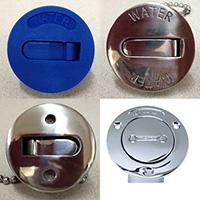My normal procedure is to winterize my engine and generator while in the water. I close the seacocks and attach a hose to my raw water strainer. Years ago I made a special fitting to accomplish this task. The open end of the hose goes into a bucket fed by a fresh water hose. I run the engine for 10 minutes minimum and then until hot. This flushes all the salt out of the engine. Then I immediately change the oil and filter and refill with new oil. Next I move the hose to a second bucket with 50/50 antifreeze and run the engine until a pre-determined amount of antifreeze has been sucked in. I have previously measured the freeze point of the antifreeze that comes out the exhaust so I know how much to pump through to attain a -25 F freeze point for the engine and the generator. That's it until after hauling. After hauling I open all the seacocks everywhere and let them drain, then close them for the winter.
I think that one of the advantages of filling the engine raw water passages with antifreeze instead of air is that air will promote the internal rusting of the engine and the antifreeze fills all the spaces with corrosion inhibitors. I once had an Atomic 4 in another sailboat that the PO told me to simply drain the cooling passages. The first year I did this and was rewarded with a rust-blocked exhaust manifold. Thereafter I always filled the block with antifreeze and never had that problem again. YMMV.
I do however blow out the fresh water lines and drain the hot water heater. I have never added antifreeze to that system, so like Bill I never have a bad taste to flush out in the Spring.
Bad taste is the result of several common mistakes:
1. Water dilution. AF that is less than 25% glycol can ferment and get nasty. Use enough. Common mistake.
2. Too long. Don't winterize until it's cold, and break winterization early. Less time for 1.
3. Never add water to the tank. Vac it MT.
Either way, add valves so that you don't have to break fittings.
I've never had a bad taste either.




